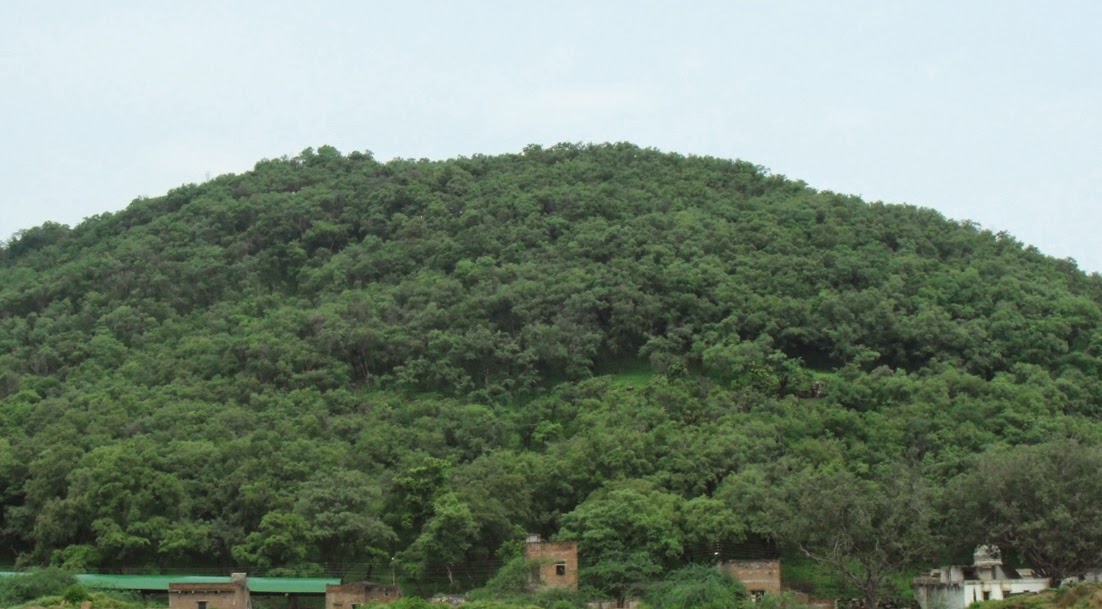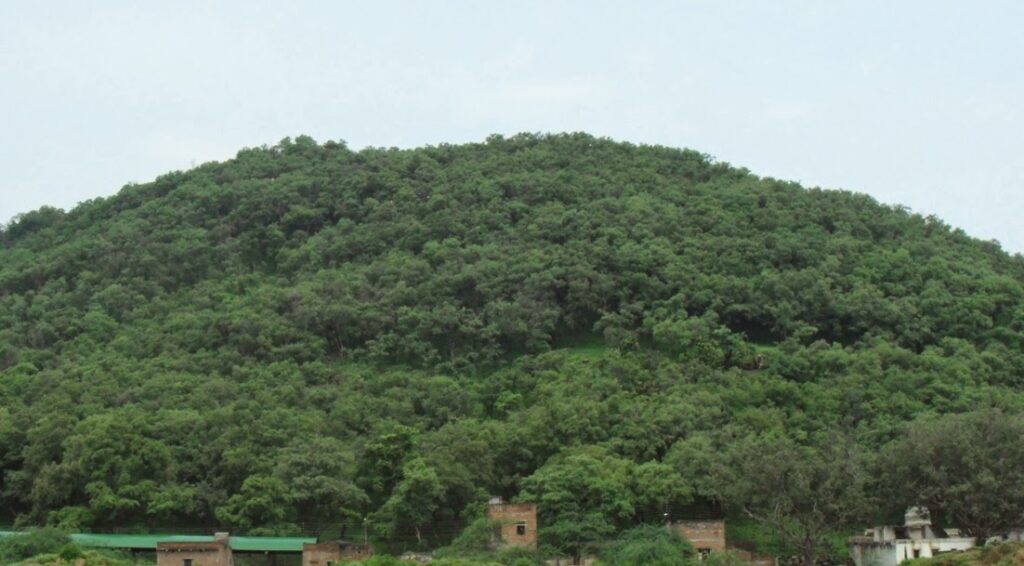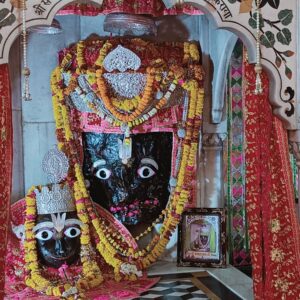
Kamadgiri, by the banks of the sacred Mandakini River is the central attraction of Chitrakoot Dham and referred to as the heart of Chitrakoot Dham. It is here that Lord Rama resided along with Sita Devi and Lakshmana. The very name Kamadgiri implies ‘the mountain that fulfils desires’. Even the very sight of Kamadgiri will make you forget everything else. Not merely forgetting, it is liberating too. The following shloka describes the essence of this sacred hill:
सुवर्ण कूटं रजताभिकूटं, माणिकयकूटं मणिरत्नकूट्म। अनके कूटं बहुवर्ण कूटं, श्री चित्रकूटं शरणं प्रपद्य।।
“Kamadgiri is the crown jewel of Chitrakoot and it is full of different kinds of gems and jewels of different colours. The presence of Lord Rama on the hill made it abundant in flowers, fruits and other things”
The Origin of Kamadgiri
According to the Ramayana, Lord Rama spent some time of the vanavasa in Chitrakoot, atop Kamadgiri. When Lord Rama resided on Kamadgiri, many sages arrived in Chitrakoot and began residing here to have association of Lord Rama. Due to this, the hill got purified and achieved the status of pilgrimage. Eventually it became the favourite place of the sages.
After the incident of Bharata’s arrival at Chitrakoot, Lord Rama decided to leave the latter. When the residents of Chitrakoot received this news, they felt sad including the mountain itself. In great grief, Kamadgiri approached Lord Rama and told Him that until He was residing in Chitrakoot, all the great personalities were residing here. After Lord Rama’s departure, none would come here and forget the sacred of hill.
Hearing this humble plea, Lord Rama gave the Kamadgiri a boon that the hill would fulfil the desires of devotees from then on. Whoever would perform the parikrama of this hill would have their desires fulfilled and also attain the mercy of Lord Rama. Lord Rama would reside here eternally. Hence, Kamadgiri became sacred, presided over by the presence of Lord Kamtanath, Who is none other than Lord Rama.
It is said that once Garuda and Vayudev had a duel to decide who is greater amongst themselves. Garuda had held Sumeru Parvata and Vayudev was supposed to release the grip of Garuda from the mountain. One by one, Vayudev started blowing 49 types of air, but none of them could disturb Garuda’s hold even slightly. Then Vayudev put all his might and started blowing the air which appeared to be very pleasant, and which made Garuda to sleep. Due to the force of the wind, the two wings of Garuda flew and fell at Chitrakoot.
Garuda felt disappointed and approached Lord Narayana, who blessed him that in the future the place where his wings fell, would become the residence of Lord Rama and great sages. All the devatas would perform tapasya there. Then, Garuda would be born as Kamadgiri, a great hill which will be worshiped by devotees. It is also said that Lord Brahma had performed a grand yagna on the hill during the time of creation. There were 108 yagna kundas out of which one remain there till date.
Kamadgiri Parikrama
Lord Rama had blessed Garuda, that anyone who performed the parikrama of Kamadgiri, would be blessed and would have one’s desires fulfilled. Even today devotees perform the sacred parikrama of Kamadgiri which is around five kilometres long. Some devotees perform dandavat parikrama, paying dandavats at every step. Though this may take hours, some devotees perform this out of intense love for Lord Rama. Being able to walk or roll on the hill where the lotus feet of Lord Rama, Sita Devi and Lakshmana touched the ground, is something unforgettable.
Four Entrances of Kamadgiri
The sacred hill is in the shape of a bow. A very interesting fact about the hill is that Kamadgiri is hollow, and it has four entrances in the four directions to reach the inner part of the hill. Over a period, these entrances are blocked. The hill showcases the four faces aspect of Lord Ramachandra.
Each entrance of the hill is marked by the presence of Lord Kamtanath’s mukharavinda or the face. The northern entrance, which is the most important of all, is marked by the prominent temple of Sri Kamtanath, the presiding Deity of Kamadgiri, along with the mukharvinda of Hanuman. The eastern entrance marks the presence of two vigrahas of Lord Kamtanath out of which one is swayambhu. The other one was installed by the king of Panna, Sri Amaan Singhji Maharaja. This vigraha has seven shaligrama shilas in its mouth. There is a peepal tree which was planted by Tulsidas ji in this dwara.
The southern entrance of Kamadgiri is known as Surabhi Dwara or Gau Dwara. This was opened until recently. Mother Surabhi used to reside here. The third entrance of the hill is known as Kamadhenu Dwara and is marked by the presence of Mukharavinda of Lord Kamtanath at Khohi village. The western entrance is the fourth entrance of the hill and is flanked by the fourth Mukharavinda of Lord Kamtanath.
Parikrama Path of Kamadgiri
The parikrama path begins from the northern entrance of the hill called Kamathnath though there are entrances in all the four main directions. Ideally, the parikrama begins with a dip in the sacred waters of the Ram Ghat. It is five kilometres long and you can perform pujas at the temples on the path after purchasing puja materials from the small stores enroute. It hosts the following sacred spots – Bharat Milap Temple – Kamtanath Temple – Bharat Janak Milap Temple – Barha Hanuman Temple – Lakshman Pahari – Old Adi-Kamad Mukharavind Temple – Second Kamtanath Mukharavind Temple – Third Kamtanath Mukharavind Temple – Guru Vasisht Ashram – Sharabhang Ashram – Sakshi Gopal Temple – Narsingh Temple and many more small temples and sacred spots can be seen and worshipped on the parikrama path.
Best Time to Visit Kamadgiri
Winter is the best season to travel or July to March are the best months to visit Kamadgiri. If you wish to relish the waterfalls and the rivers of Kamadgiri, then you may plan to visit in the rainy season.
How to Reach Kamadgiri
If you are thinking right now or even in the future about going on a parikrama of Kamadgiri, no better option can be recommended than the Ayodhya Kashi Yatra by Tirtha Yatra.
Once you reach the town of Chitrakoot, you will get autorickshaws to the entrance of the parikrama path. These modes of transportation will help you reach Chitrakoot –
By Road: Chitrakoot is well connected by regular bus service from cities and towns in both Madhya Pradesh and Uttar Pradesh. This includes private bus services as well as state bus services from Prayagraj, Lucknow, Kanpur, Varanasi, Satna and more places.
At a distance of 75 to 80 kms, Satna is the nearest city. Alternatively, you can hire taxis from these cities.
By Rail: Chitrakutdham Karwi Railway Station is the nearest railway station at a distance of 8 to 10 kms. You can alight here and catch a bus or hire a taxi to Chitrakoot.
By Air: The Bamrauli Airport in Prayagraj is the nearest airport at a distance of 111 kms. You can fly in here and use the rail or road route to reach Chitrakoot.
0












Leave a Reply